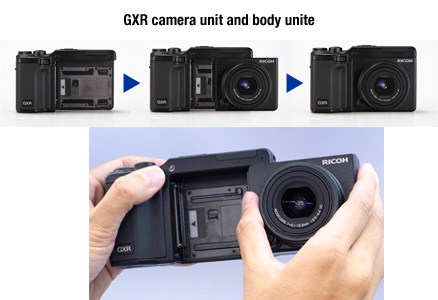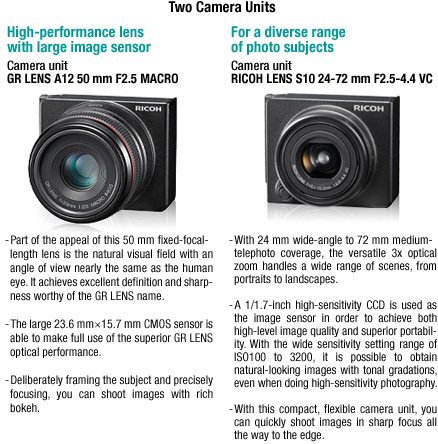Inside Story

![[Planning and Design] What is this new-concept, boundary-shattering interchangeable unit camera system called the GXR?](/english/products/gxr/story/01/img/cts_top_02.jpg)
- Planning and Design
- Design and Development
- Future Prospects
The interchangeable unit camera system is born: World's smallest and lightest! *
First of all, please take a look at the "Interchangeable unit camera system GXR" special site on the Internet. This site should give you an intuitive feel for the kind of camera that the GXR is. Appearing first is the camera exterior with no lens. Sliding in to unite with the body are units consisting primarily of a lens. For a moment you may question what your eyes showing you here, but, yes, the result of each combination is one complete camera.
- *World's smallest and lightest: Internal flash, interchangeable lens digital cameras with lens attached. As of November 10, 2009, Ricoh research.


"By changing camera units, you can
quickly obtain the optimum shooting
capabilities." (Akihiko Okamoto)
"The GXR is a new camera system consisting of a body and camera units. Changing camera units makes it possible to instantaneously handle a wide variety of shooting condition so the photographer can enjoy the GXR's superb expandability as a camera," said Akihiko Okamoto, Marketing Group member in the Personal MultiMedia Products Company Planning Office.
What is a camera unit?
With an SLR camera, the photographer changes lenses in order to get the exact image desired. A wide-angle zoom is best for landscapes and souvenir photos, a standard zoom lens is generally appropriate for portraits, a telephoto zoom is good for astronomical photography, a macro lens is necessary for close-ups of insects and flowers, and so on. To get a wide viewing angle, to emphasize distance, to blur the surroundings, and to achieve various other effects, the photographer makes use of the special characteristics of different lenses with different focal lengths.
In the case of an SLR, the only thing changed is the lens. With the GXR, however, you change the "camera unit," which includes not only the lens but also a CCD *1 or CMOS *2 image sensor *3 and an image processing engine. The following two camera units are now available so you can use the one that best fits the situation. In the future, Ricoh plans to add a diverse variety of other units.
- *1)CCD
Abbreviation for Charge Coupled Device.
One type of image sensor, the CCD sensor is a semiconductor device widely used in video and digital cameras. It is particularly suitable when small size is required. - *2)CMOS
Abbreviation for Complementary Metal-Oxide Semiconductor.
This is another image sensor that, like the CCD sensor, is used in digital cameras. It is particularly suitable when high speed is required. - *3)Image sensor
The image sensor converts light into an electrical signal. It fulfills the same function as film in a film camera. There are a number of different types, including CCD and CMOS.

Stainless steel guide rails are, of course, used for the slide mechanism in order to provide strength and smooth sliding. Camera system mount reliability has been verified in repeated high-stress attachment/removal testing.
So what led to the decision to develop the interchangeable unit camera system? "We wanted to give camera users a whole new way to enjoy photography. And to do this, we needed to transcend the limitations of existing compact digital cameras and radically expand their photographic range," Okamoto said.
"As a matter of fact, the concept itself first appeared quite a number of years ago in response to user comments such as this: 'SLR cameras can take good pictures, but because they are so heavy and bulky, they end up being left at home. It would be nice to be able to take photographs at close to SLR quality levels using a compact-size camera.' Considering our Ricoh product development concept of the Candid Photo (An image quickly captured in that instant when the heart stirs), we really wanted to respond to that user need, but we did not move forward at the time because we were not sure how widely accepted such a camera would be. In recent years, however, the increase in the number of people not satisfied by digital compact cameras and the appearance of certain technical innovations created an environment in which we felt we could finally take on the challenge of developing a product like the GXR."
- *Lens focal lengths in the text are all converted to 35 mm film camera equivalents.
- Planning and Design |
- Design and Development |
- Future Prospects


